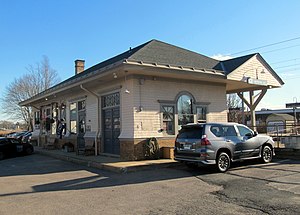Mystic station (Connecticut)
|
Mystic
|
|||||||||||||
|---|---|---|---|---|---|---|---|---|---|---|---|---|---|

Mystic station in December 2017
|
|||||||||||||
| Location | 2 Roosevelt Avenue Mystic, Connecticut |
||||||||||||
| Coordinates | 41°21′03″N 71°57′48″W / 41.3509°N 71.9632°WCoordinates: 41°21′03″N 71°57′48″W / 41.3509°N 71.9632°W | ||||||||||||
| Line(s) | Northeast Corridor | ||||||||||||
| Platforms | 2 side platforms | ||||||||||||
| Tracks | 2 | ||||||||||||
| Other information | |||||||||||||
| Station code | MYS | ||||||||||||
| History | |||||||||||||
| Opened | 1905 | ||||||||||||
| Traffic | |||||||||||||
| Passengers (FY 2016) | 25,714 |
||||||||||||
| Services | |||||||||||||
|
|||||||||||||
|
|||||||||||||
Mystic is an intercity train station on the Northeast Corridor, located off Roosevelt Avenue (US 1) east of downtown Mystic, Connecticut. It is served by a limited number of trains on Amtrak's Northeast Regional service, with three to five daily trains in each direction. Mystic is one of only three stations on the Northeast Corridor (along with adjacent stations Westerly and Kingston to the north) to be served exclusively by Amtrak, with no commuter rail service.
The current station building was built in 1905-07, replacing a station built half a century before. A classic small American train station, it was used as the model for American Flyer model stations for over 50 years. The station only has low platforms, unlike most Amtrak stations on the Northeast Corridor; however, a wheelchair lift is available for handicapped accessibility. The station building is used as a coffee shop and passenger waiting area.
The New Haven, New London and Stonington Railroad opened from Stonington to Groton in on December 30, 1858, and was shortly thereafter acquired by the New York, Providence and Boston Railroad. A wooden depot was built at Mystic; it may have been replaced later in the century.
A new station was built in 1905-07 by the New York, New Haven, and Hartford Railroad. The station is primarily wood on a brown brick base, with Georgian Revival architectural elements such as Palladian windows on the east and west facades. It is clad in wood shingles, which had become popular in New England in the late 19th century as a result of interest in colonial history. The eastern half of the station was a waiting room for passengers, while the western half was a baggage room with few windows.
...
Wikipedia
